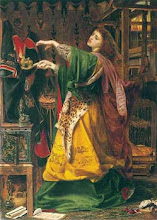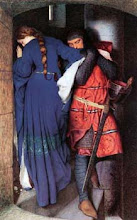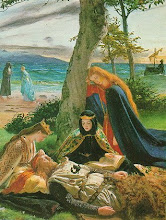Published: March 19, 1985
A BRITISH scholar has uncovered evidence that he says establishes the identity of the man who may well have been the model for the mythic Arthur, the once and future king of legend. The real Arthur, according to the new findings, was probably a fifth-century ''high king'' of the Britons known as Riothamus.
In a detailed analysis of the few written accounts of the time, the scholar, Geoffrey Ashe, a historian who has worked closely with archeologists, found a striking coincidence between Arthur's supposed exploits in Gaul and the documented expedition of Riothamus. He is known to have led an army of Britons in a vain struggle to expel the barbarian Goths from the pro-Roman region of Burgundy. Like Arthur, he advanced into Burgundy, was betrayed by an associate, fought bravely but was defeated and disappeared from history in about 470. Further research gave Mr. Ashe reason to suspect that Arthur and Riothamus were one and the same. He and Leon Fleuriot, a Celtic scholar at the Sorbonne in Paris, working independently, discovered that Riothamus is not a name but a title, meaning ''high king.'' Since history records no other name for the king, Mr. Ashe decided, after years of what is called manuscript archeology, that he had quite probably ''found'' the man who was Arthur.
In ''The Discovery of King Arthur,'' published recently in association with Debrett's Peerage, Mr. Ashe wrote: ''In the High King called Riothamus we have, at last, a documented person as the starting point of the legend. He is the only such person on record who does anything Arthurian. Or to put it more precisely, he is the only one to whom any large part of the story can be related.''
The finding is not likely to diminish the Arthur of medieval romances, which are glorious fictions about a magic sword and the prophetic Merlin, gallant knights of the Round Table and the ''brief shining hour'' of Camelot, the adulterous love between Lancelot and Guinevere, Galahad's quest for the Holy Grail, and the king's ultimate defeat and disappearance to Avalon. This Arthur, though he never lived, is immortal.
But Mr. Ashe's conclusions are certain to stir controversy among the scholars who have long sought to establish the historical basis, if any, for the Arthurian legend. Some scholars doubt that there ever was a real Arthur. Others believe he was a general, not a king, who fought the invading Saxons and after death was given heroic stature in Welsh and Breton folklore. Still others question whether he ever extended his military reach to the Continent.
Norris J. Lacy, president of the International Arthur- ian Society and a scholar of medieval French literature at the University of Kansas, called Mr. Ashe's study ''the most complete and best-researched'' attempt so far to identify the real Arthur. ''Many people are still viewing it with some reserve,'' Dr. Lacy added, ''but the arguments are relatively convincing and Ashe is making some converts.''
The hypothesis is likely to inspire new studies of the Arthur question and give added impetus to the small but active groups of archeologists digging for traces of the fortresses, villas and other artifacts from the time of Arthur, a chaotic time in British history that invited legend because so little about it is known.
When Rome withdrew its legions early in the fifth century, ending centuries of rule in the British Isles, the Britons, a Celtic people, were left on their own. They soon disintegrated into petty kingdoms vulnerable to attack. To shore up defenses, an ambitious nobleman, Vertigern, brought in Angle and Saxon mercenaries who then turned on their employers. The ultimate Anglo-Saxon takeover was forestalled by an army of Britons led by a king - either Arthur or someone like him.
Since there are no contemporary accounts from this time, the legend of Arthur grew mainly out of Welsh stories passed on from generation to generation. It was one people's way of recalling their former greatness. In about 1135, Geoffrey of Monmouth embellished the stories in writing a ''history'' of the British kings, and this became the primary source of medieval tales celebrating Arthur's reign and his presumed battles in Gaul.
Reign Set From 454 to 470
For his study, Mr. Ashe re-examined Geoffrey's book as well as earlier writings by a certain Jordane, in the 6th century, and someone known only as William who wrote the ''Legend of St. Goeznovius'' in the 11th century. He thus determined that Arthur presumably reigned from 454 to 470 and campaigned in Gaul when Leo I was Emperor in Constantinople, in the late 460's. This coincided with the time Riothamus led British forces into Gaul.
Mr. Ashe noted that Jordanes wrote of the ''king Riotimus'' who came with 12,000 men into Brittany ''by way of Ocean.'' Then, as he said in an interview last week, Mr. Ashe found ''the most certain proof'' of Riothamus's existence and his presence in Gaul in the late 460's. The evidence, which had been overlooked, was a letter written by Sidonius Apollinaris, an aristocrat living in Rome, to Riothamus in a region south of the Loire River.
After Mr. Ashe first described the probable link between Riothamus and Arthur, he learned that a historian in 1799, Sharon Turner, had the same idea but never pursued it further. In ''History of the Anglo-Saxons,'' he wrote in a footnote, ''Either this Riothamus was Arthur, or it was from his expedition that Geoffrey, or the Breton bards, took the idea of Arthur's battles in Gaul.''
Riothamus suffered a defeat in battle at the town of Deols across the Indre River from Ch^ateauroux. The king was last heard of as passing from history in Burgundy. Mr. Ashe said his probable route of escape took him through a French town called Avallon to this day.
In his book, Mr. Ashe concluded: ''We now have evidence in four quite different settings - not only Geoffrey's fiction, but the folklore of the Celtic fringe, Breton hagiography and Franco-German chronicle-writing - for the name Arthur denoting this King. This looks like the solution.''
Some Scholars Are Skeptical
Frederick C. Suppe, a Celtic scholar at the University of Minnesota, said that Mr. Ashe's research was ''respectable from a scholarly point of view,'' though he was ''dubious'' that Arthur ever fought on the Continent. ''I'd be willing to listen and consider the case,'' he added.
Dr. Suppe said the new study was an example of the ''more systematic'' research directed in recent years at questions raised by the Arthurian legend. Scholars are re-examining the Celtic folk legends for recurring themes and possible underlying fact. And archeologists have begun to explore the legend with vigor.
In the 1960's, archeologists uncovered in Somerset the stone remains of a fortress at Cadbury Hill, the supposed site of Arthur's Camelot. Pottery found there was identified as being similar to known fifth century pottery. Leslie Alcock, professor of archeology at the University of Glasgow and leader of the excavation, said the ramparts and architecture of the fortress suggested a grandeur befitting a king - not a castle in the medieval sense of the Arthurian legends, but perhaps more than the headquarters of a military commander. Dr. Alcock, however, has refrained from making a judgment on the reality of Arthur.
Excavation of Roman-Style Villa
John Kenfield, an archeologist at Rutgers University, will be returning to England this summer to resume excavation of a Roman-style villa near Avebury in Wiltshire. The villa is near the site of the Battle of Badon, where Arthur is supposed to have defeated the Saxons.
Nothing dug up so far points to Arthur, Dr. Kenfield emphasized, but pottery place the time of the villa in the late fifth century. He said the villa could provide clues to life at the time Britain was passing from Roman to Saxon hands.
Mr. Ashe said he hoped that future archeologists will dig around the area where Riothamus battled the Goths in France. Finding some British weapons from Arthurian times, he said, would re-inforce his thesis that in Riothamus he has found the real King Arthur.













































